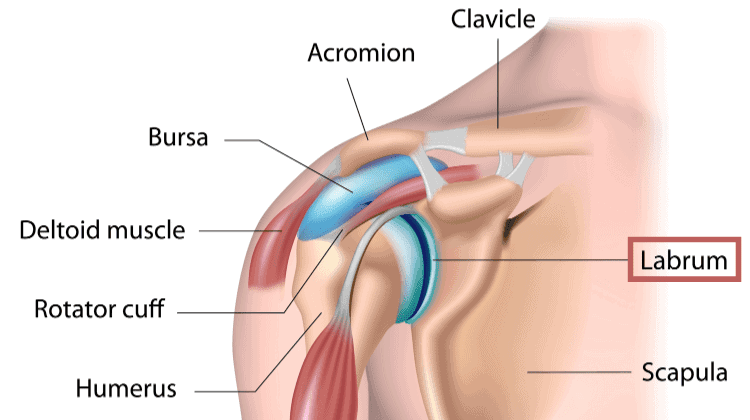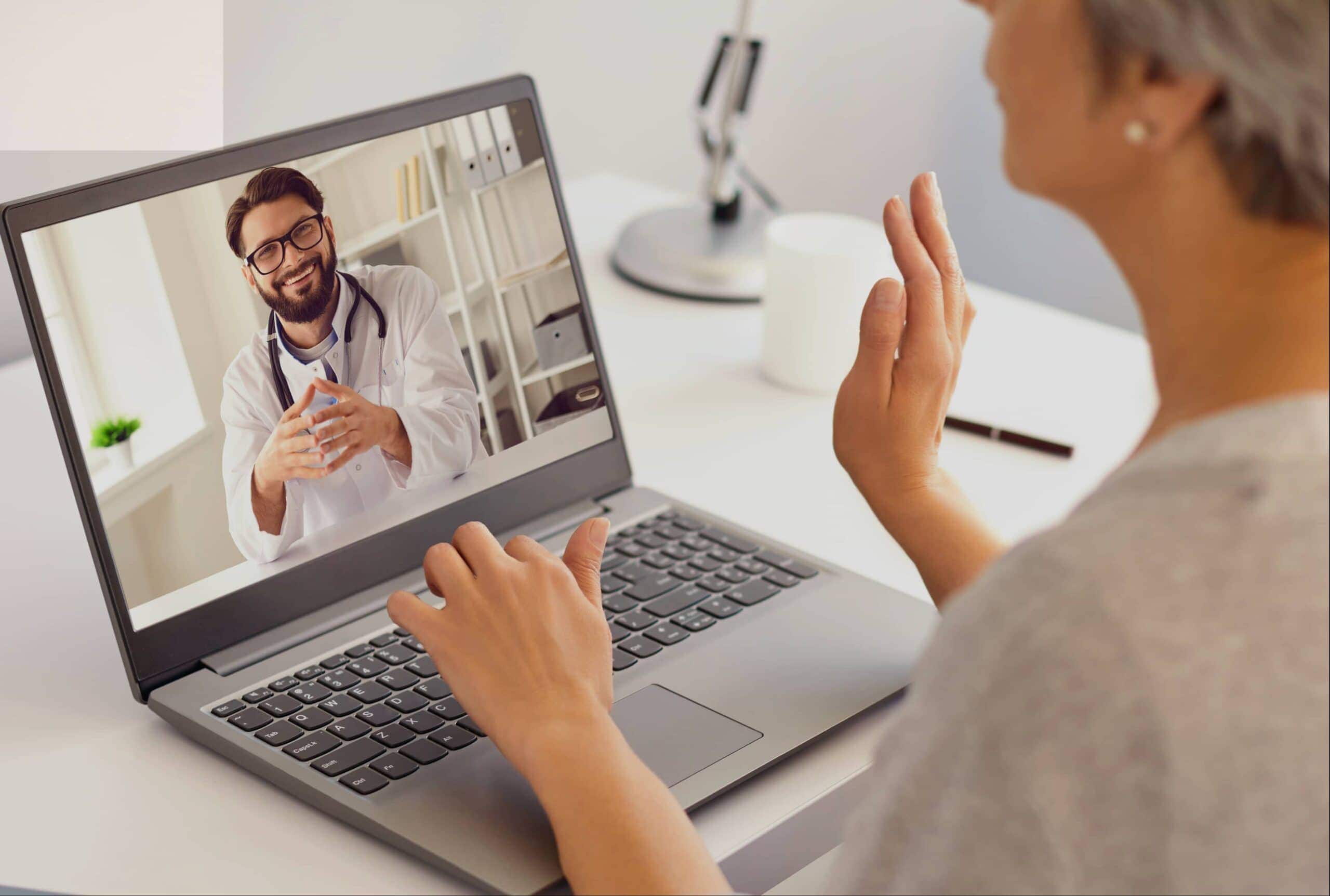Shoulder Labrum Tear Treatment – Annapolis, MD
The labrum is a cup-shape rim of cartilage that lines and reinforces the ball-and-socket joint of the shoulder. It’s the lip of the socket of the ball and socket joint. It helps to connect the socket part of the scapula with the head of the humerus. It makes the socket deeper, creating space for the bones to move, and coats the surface of the socket area with soft cartilage, enabling the shoulder to move more freely and painlessly.
A shoulder labrum tear can be caused by a direct injury to the shoulder or as the result of prolonged wear and tear.1 While labral tears can occur in big traumas, like a car crash or a serious fall, shoulder instability is a cause often missed. 2 Instability can slowly increase after an old injury or a seemingly less traumatic event.
Imagine that the ball of the humerus is a bowling ball and that the labrum a barrier between the lane and gutter. When the shoulder is stable, the ball stays on the lane. When the shoulder is unstable, the ball continuously goes towards the gutter and hits the barrier (labrum).

How Successful Is Shoulder Labrum Repair Surgery?
The common surgical intervention for labral tears often involves an invasive procedure to reattach the biceps tendon at another location. Labral repair tends to be followed by a long, painful recovery with extensive physical therapy — often with no improvement in mobility and function. Also, labrum surgery frequently fails to address the subtle instability of the shoulder joint that caused the tear, so the shoulder remains unstable and subsequent injuries may occur.
There has only been one high-level study that compared surgical labral repair compared against a fake surgery. It did not show any difference in outcome between the labral repair surgery and the fake procedure 3. In another study looking at posterior shoulder instability, surgery edged out physical therapy, but the patients knew what procedure they were getting 4. We don’t have much solid evidence that a shoulder labral repair procedure works.
166 Defense Highway
Suite 300
Annapolis, MD 21401
Request an Appointment
Call to Schedule Schedule OnlineClinic Hours
| Sunday | Closed |
| Monday | 8AM-4PM |
| Tuesday | 8AM-4PM |
| Wednesday | 8AM-4PM |
| Thursday | 8AM-4PM |
| Friday | 8AM-2PM |
| Saturday | Closed |

Treat Labral Tears Without Surgery
Regenexx procedures are non-surgical treatments that use your body’s own healing agents to treat shoulder labral tears. Our patients benefit from reduced pain and improved function, helping them avoid shoulder surgery.
Am I a candidate?Regenexx Procedures for Labral Tears
Regenexx’s percutaneous labralplasty is a nonsurgical procedure that uses precise imaging guidance and your own healing cells to promote natural healing. Regenexx procedures can be a better alternative for people looking to avoid surgery, lengthy recovery, and overuse of prescription pain medication. They use either platelet-rich plasma or bone marrow concentrate (which contains stem cells).
The nature and severity of your labral tear (classification type) generally determines if the treatment is right for you. An evaluation by a Regenexx physician is the first step.
Find a Location
Find a physician in licensed Regenexx network.
Labral Tear Repair Patient Stories
I tell people about it all the time, and they find it so hard to grasp…100% and no scars, no downtime….I am so happy with my results and just wanted to say THANKS once again.”
Pilates lover with an active lifestyle – Full patient story
Number 8 [at 3 minutes and 35 seconds] is Matt scoring the winning goal for Penn State lead over Cornell. He had 2 great goals! THANK YOU…he feels great:)”
Mother of a college athlete – Full patient story
Note: Like all medical procedures, Regenexx procedures have a success and failure rate. Not all patients will experience the same results.

Webinar: Alternatives to Shoulder Labrum Surgery
Learn the latest about regenerative medicine, and how Regenexx procedures can treat your shoulder labrum injury.
Watch WebinarPatient FAQs
Yes, not everyone experiences pain when their labrum is torn. In 2016, a study performed MRIs on patients without shoulder pain who were 45-60 years old, a staggering 55-72% of these people had labral tears. 5
Yes. When the tear is in the upper part of the labrum, the area where the biceps tendon attaches to the lap of the socket is also commonly torn. When this happens, it’s called a SLAP tear (Superior Labral Tear from Anterior to Posterior).
Request an Appointment
References
1. Clavert P. Glenoid labrum pathology. Orthop Traumatol Surg Res. 2015 Feb;101(1 Suppl):S19-24. doi: 10.1016/j.otsr.2014.06.028. Epub 2015 Jan 14. PMID: 25596985.
2. Van Blarcum GS, Svoboda SJ. Glenohumeral Instability Related to Special Conditions: SLAP Tears, Pan-labral Tears, and Multidirectional Instability. Sports Med Arthrosc Rev. 2017 Sep;25(3):e12-e17. doi: 10.1097/JSA.0000000000000153. PMID: 28777213.
3. Schrøder CP, Skare Ø, Reikerås O, Mowinckel P, Brox JI. Sham surgery versus labral repair or biceps tenodesis for type II SLAP lesions of the shoulder: a three-armed randomised clinical trial. Br J Sports Med. 2017 Dec;51(24):1759-1766. doi: 10.1136/bjsports-2016-097098. Epub 2017 May 11. PMID: 28495804; PMCID: PMC5754846.
4. Schwartzberg R, Reuss BL, Burkhart BG, Butterfield M, Wu JY, McLean KW. High Prevalence of Superior Labral Tears Diagnosed by MRI in Middle-Aged Patients With Asymptomatic Shoulders. Orthop J Sports Med. 2016 Jan 5;4(1):2325967115623212. doi: 10.1177/2325967115623212. PMID: 26779556; PMCID: PMC4710128.
5. Cruz-Ferreira E, Abadie P, Godenèche A, Mansat P, Clavert P, Flurin P; French Arthroscopy Society. Posterior shoulder instability: Prospective non-randomised comparison of operative and non-operative treatment in 51 patients. Orthop Traumatol Surg Res. 2017 Dec;103(8S):S185-S188. doi: 10.1016/j.otsr.2017.08.004. Epub 2017 Sep 2. PMID: 28873349.
- Hip Labrum Surgery Mania
- Torn Hip Labrum and Hip Osteoarthritis
